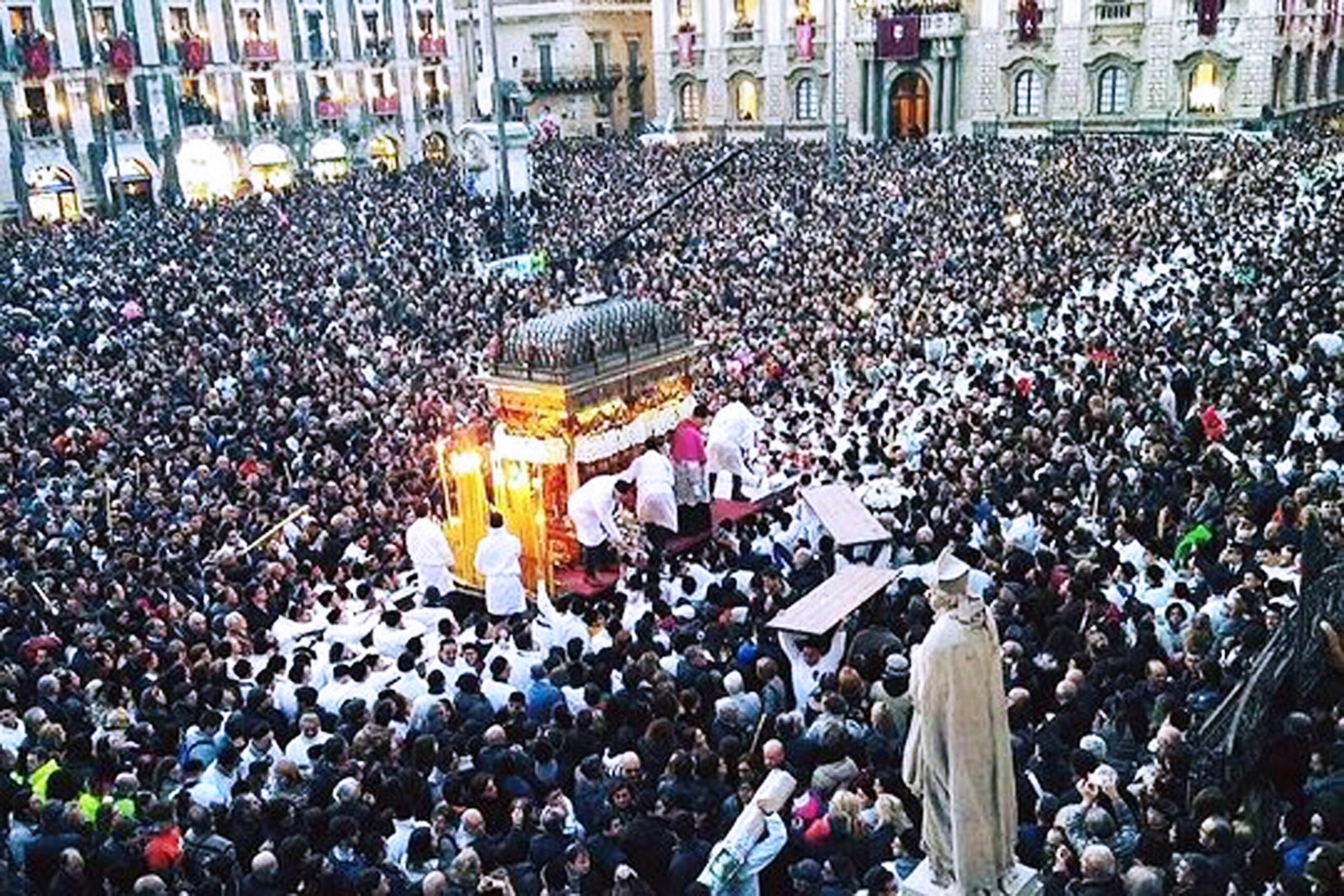Early February has been a special time in Catania, Sicily, for centuries. From February 3rd to the 5th, a whirlwind of emotions accompanies the three incredible days dedicated to the Santuzza, as the residents refer to the festival, which involves hundreds of thousands of devoted locals and visitors to the city.
Agatha, one of the most highly venerated virgin martyrs of Christian antiquity, was put to death during the persecution of Decius (250–253) in Catania, Sicily, for her determined profession of faith.
Although she came from a rich and noble family the fifteen-year-old Agatha embraced the Christian faith and made a vow of virginity. She rejected the amorous advances of the Roman Prefect Quintianus, who thought he could force her to turn away from her vow and marry him. His persistent proposals were consistently spurned by Agatha. Quintianus, knowing she was a Christian, had her arrested and brought before him, where he acted as the sole judge in deciding her fate.
He expected Agatha to give in to his demands when she was faced with torture and possible death, but she simply reaffirmed her belief in God by praying “Jesus Christ, Lord of all, you see my heart, you know my desires. Possess all that I am. I am your sheep: make me worthy to overcome the devil.”
With tears falling from her eyes, she prayed for courage. To force her to change her mind, Quintianus imprisoned her in a brothel. Agatha never lost her confidence in God, even though she suffered a month of assaults, unspeakable degradations and efforts to get her to abandon her vow to God and go against her virtue.
Quintianus sent for her again, argued, threatened and finally had her put in prison, where she was tortured. She was stretched on a rack to be torn with iron hooks, burned with torches and whipped. Her breasts were cut off with pincers. Agatha was then sentenced to be burned at the stake, but an earthquake saved her from that fate. Instead, she was sent to prison where St. Peter the Apostle appeared to her and healed her wounds.
Agatha died in prison in 251. On February 1, 252, Catania was threatened by a violent eruption of Mount Etna. The terrified inhabitants of the nearby villages took the veil that was wrapped around Agatha’s tomb and used it as a shield against the lava flow. The white veil suddenly turned red and stopped the eruption; the date was February 5, the day of her martyrdom anniversary.
The opening day of the festival is devoted to the procession of the cannalori, where eleven huge candles enshrined in elaborate gilt Baroque casings and weighing up to a ton are carried through the streets accompanied by a marching band and cheering crowds. During ‘A sira ‘O Tri (the evening of the 3rd ), Piazza Duomo is the scene of a concert of songs dedicated to Sant’Agata, followed by a pyrotechnic firework display to round off the first day’s events.
For many, the second day of the festa is the most special. Sant’Agata’s reliquary statue is carried out of the Cathedral and through the crowded streets of the city in a day-long procession that stops off at all the places that have a connection with the saint’s life, including the Church of Sant’Agata alla Fornace, the site of her martyrdom. The townspeople from Catania traditionally wear black skullcaps and white tunics for the procession. They wave white handkerchiefs and chant “Tutti devoti tutti, cittadini, viva Sant’Agata,” which translates to, “Are we all devotees? Townspeople, long live Saint Agata!” As evening falls, the statue is taken back to her resting place in the Cathedral.
The climax of the festa in on February 5th. After a Solemn Mass and a day of reflection, at 6:00 pm, the reliquary statue of Sant’Agata is once more brought out of the Cathedral for another tour of the city, up Via Etnea, across to the Church of Sant’Agata al Borgo (where she is greeted by another firework display) and then back down to the bottom of the steep Via San Giuliano for the cchianata ‘i Sangiulianu. Here the statue bearers give a demonstration of their courage, faith and devotion by running to the top of the road with the heavy load, urged on by a cheering crowd. A final stop is made outside the Benedictine Convent in Via dei Crociferi, before the statue is once more returned to the Cathedral. More fireworks, general rejoicing and a fantastic party then ensue. Visitors will find pastries and cakes related to the young virgin’s story in most every pastry shop in Catania.





